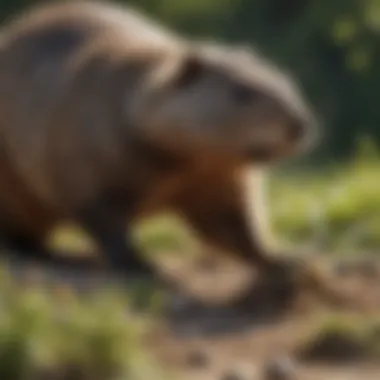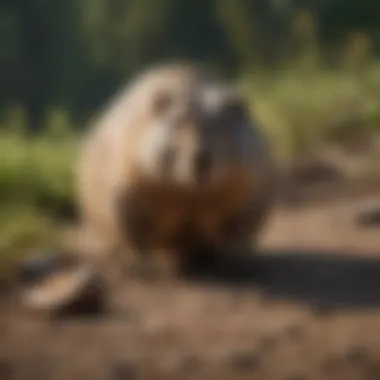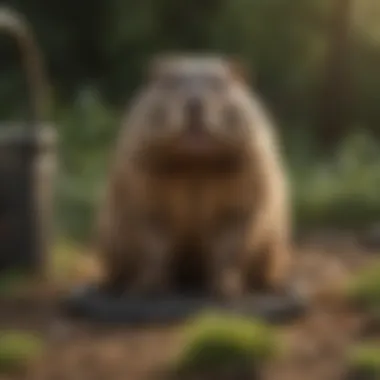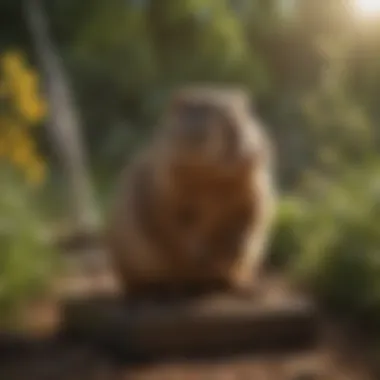Effective Groundhog Trap Bait Strategies and Tips


Intro
Effectively dealing with groundhogs requires a solid understanding of their habits and preferences. Groundhogs, also known as woodchucks, exhibit distinct behaviors that can influence the success of your trapping efforts. If you're looking to manage these critters in your garden or yard, knowing what to use as bait is essential.
Groundhogs are herbivores and have a penchant for various plants, but not all potential bait options are equally enticing to them. In this guide, we'll explore the types of bait that attract groundhogs and delve into strategies that can make your trapping experience more fruitful.
The knowledge you gain here will not only enhance your trapping success but also align with humane practices in pest management. Let's embark on this journey to become savvy groundhog trappers.
Pest Identification
Identifying groundhogs accurately is the first step toward effective trapping. Understanding their behavior and the signs of their presence can save time and resources while increasing your chances of a successful capture.
Common Household Pests
While groundhogs are the focus here, it's important to recognize how they fit into the ecosystem of household pests. Many may confuse them with similar species such as squirrels or rabbits. Groundhogs are typically larger than these animals, measuring about 16 to 26 inches in length.
Signs of Infestation
Groundhogs usually make their presence known in several clear ways:
- Burrows: Look for holes in the ground, typically 10-12 inches in diameter. These burrows often have loose dirt around them.
- Feeding Damage: If you notice bite marks on garden plants or grass, it's a telltale sign of these rodents.
- Tracks: Groundhog tracks are distinguishable; they feature five toes on each foot and are about 2-3 inches long.
- Feces: Droppings are dark brown and about three-quarters of an inch long. Finding these can confirm the presence of groundhogs in your area.
Foreword to Groundhogs and Trapping
Understanding groundhogs and their trapping is not just a matter of pest control; it touches upon the broader themes of wildlife management and ecological balance. Groundhogs, also known as woodchucks, are hardy creatures that can wreak havoc in gardens and yards if left unchecked. This makes understanding their behavior and the rationale behind trapping them utterly essential for homeowners and gardening enthusiasts.
Trapping is often seen as a last resort, but it can be a crucial part of integrated pest management. It not only protects your plants but also offers a method to control their population humanely. By delving into the nuances of groundhog behavior and the effectiveness of various trapping methods, readers will grasp how much thought must go into selecting the right bait—and how bait efficacy can vary from season to season or according to individual animal preferences.
"Understanding what attracts groundhogs can elevate any trapping strategy from hit-or-miss to focused and effective."
Thus, this article will illuminate the significance of choosing the right trap bait, enabling readers to optimize their efforts in managing these bushy-tailed residents in their backyards. By employing the right strategies and considerations, you shrink the chances of failing and increase your success rate significantly.
Understanding Groundhog Behavior
Digging a little deeper into groundhog behavior gives us crucial insights into effective trapping. Groundhogs are primarily herbivorous, indulging themselves in a diet rich in vegetables, fruits, and occasionally snacking on green shoots. However, behavioral patterns show they become particularly active during dawn and dusk, when they forage for food. Their burrowing habits also indicate they need a robust territory, often causing them to return to familiar locations.
Knowing when and where groundhogs typically dwell can enhance your trapping strategy significantly. By observing their movements and preferences, you can choose bait that really resonates with them, making it much simpler to lure them into a trap.
Why Trapping is Necessary
Trapping serves multiple purposes that benefit both the garden and the local ecosystem. Without management measures, groundhog populations can escalate rapidly, leading to increased competition for food resources among wildlife. Furthermore, as groundhogs burrow, they create tunnels that can erode soil and destabilize the area, potentially leading to structural damage to sidewalks, patios, and even foundations.
Think of it this way: allowing unchecked populations to thrive can lead to garden ruin and additional costs in property repair down the line. Employing trapping when necessary is not merely about keeping the flowers flourishing; it is a proactive way to address ecological imbalance and preserve the integrity of your landscape.
The Role of Bait in Groundhog Trapping
When it comes to trapping groundhogs successfully, the bait you choose can be the difference between an empty trap and a well-caught groundhog. Bait serves as a powerful attractant that can lure these critters into traps, and understanding its role is essential for effective pest management. Groundhogs are notorious for their cunning nature; they know their surroundings well, and it takes more than just any bait to catch their inquisitive attention. This section will delve into two critical aspects: why bait matters and the types of bait that can be used.


Why Bait Matters
Bait is not merely a matter of tossing something in the trap and hoping for the best. Its significance is rooted in understanding the groundhog’s preferences and behavioral patterns. Groundhogs are herbivores with a strong taste for specific plants and foods. Utilizing the right bait ensures that you maximize your chances of capturing these animals effectively.
- Attractiveness: Groundhogs are instinctively drawn to certain scents and tastes. Using their preferred foods means you're more likely to entice them into the trap.
- Positioning: How you place the bait can create a pathway, guiding the groundhog right into the trap's mechanism. When groundhogs sense something they enjoy, they will venture closer to investigate, thus increasing the effectiveness of your setup.
In short, the right bait can make trapping more efficient, saving time and effort while ensuring humane practices in managing wildlife around your property.
Types of Bait for Groundhogs
There are several effective bait options that you can consider when trapping groundhogs. This variety allows you to adapt to different situations and preferences. Here’s a closer look at three primary categories of bait that can be put to good use.
Fruits and Vegetables
This is often the first choice among those who trap groundhogs. Fruits and vegetables are sweet and have appealing smells, making them irresistible to these furry grazers.
- Characteristics: Groundhogs delight in fruits such as apples, grapes, and berries. Vegetables like carrots and leafy greens are equally enticing. The fresh, juicy texture of these options makes them particularly appealing.
- Benefits: Using fruits and veggies means you’re employing natural and environmentally friendly bait options. They can be easily sourced from your pantry or garden, making them cost-effective as well.
- Considerations: However, one downside is that fresh produce may spoil quickly, especially in warm weather. Be mindful to check your traps frequently to replace bait as needed.
Nuts and Seeds
Nuts and seeds provide a different flavor profile that can also be very effective in trapping groundhogs. They present a crunchy texture that captivates groundhogs' interest.
- Characteristics: Groundhogs have a penchant for sunflower seeds and peanuts. Both types of bait are packed with calories and have strong scents that can draw the creatures in.
- Benefits: Nuts and seeds have a longer shelf life compared to fruits and vegetables, so they can stay fresh in your trap longer.
- Considerations: A potential drawback is that you may be competing with other wildlife looking for a snack, such as squirrels or birds. In that case, positioning the trap strategically can make all the difference.
Commercial Bait Options
For those who prefer a more straightforward approach, commercial bait options are available. These products are specially formulated to attract groundhogs and other nuisance wildlife.
- Characteristics: Commercial baits are often made from a mix of various seeds, grains, and sometimes enticing scents that groundhogs naturally gravitate towards. They often come in the form of pellets or pastes.
- Benefits: One major advantage is convenience. You don't have to worry about freshness like you would with fruits and vegetables. Additionally, they may be effective when used in conjunction with natural food options.
- Considerations: Yet, the downside could be cost. These products are typically more expensive than using homegrown options. Moreover, some individuals may prefer not to use synthetic or commercially manufactured items for ethical reasons.
Choosing the Right Bait
When it comes to trapping groundhogs, the bait you choose can make or break your efforts. Selecting the right bait is not just about what looks appetizing to us; it’s about understanding the tastes and habits of these creatures. Knowing how to bait your trap correctly ensures not only a higher success rate but also a more humane trapping process. Here, we delve into how various factors such as seasonality and effectiveness play a vital role in your choice of bait.
Seasonal Gravitations
Seasonal Preferences of Groundhogs
Groundhogs, or woodchucks as some call them, have specific feeding habits that change with the seasons. This characteristic is essential to understand when you're selecting bait. During spring and summer, groundhogs tend to munch on fresh greens, leafy vegetables, and tender shoots. They are particularly fond of clover and dandelion greens, which are abundant during these warmer months. This preference translates well into the trapping world, making these options not just popular but effective. Conversely, as fall arrives, their diets shift to starchy roots and nuts.
An appreciation for the particularities regarding Seasonal Preferences of Groundhogs not only increases your chances of trapping these critters but also promotes a more sustainable approach. By choosing bait that aligns with their natural foraging behaviors, you're essentially playing by their rules.
Adapting Bait Choices with Seasons
Adjusting your bait based on the season is an art that pays off, quite literally, in the form of successful traps. In spring and summer, incorporating bite-sized pieces of zucchini or strawberries can lure those wily groundhogs straight into your trap. But come autumn, a shift to hearty bait options like peanut butter paired with apples becomes the way to go.
The key concept here is adaptability; change your bait as the seasons turn. This adaptive choice maximizes your effectiveness and reflects a deeper understanding of your target. When the groundhogs are foraging for winter food, tempting them with something they crave enhances your success rate. Leaving your bait opportunities open throughout the year creates a win-win situation for trapping.
Evaluating Effectiveness


Once you've set your traps with bait tailored to the season, assessing how effective that bait is becomes your next priority. It's crucial to monitor the traps regularly and observe the behavior of the local groundhog population. Have you caught anything? If not, it might be time to reconsider your bait strategy.
For instance, placing a few fresh vegetables, nuts, or even something aromatic like vanilla extract could make all the difference. Cover your tracks by ensuring the bait isn't immediately visible to other animals, as that could deter groundhogs from approaching. The ability to evaluate and adjust your bait based on these observations not only aids your trapping efforts but also contributes to a more responsible way of managing local wildlife.
By blending understanding of seasonal habits with the art of assessing bait effectiveness, you're well on your way to mastering groundhog trapping.
Preparation for Trapping
Preparation plays a pivotal role in the success of groundhog trapping. Choosing the right trap and understanding bait application techniques can mean the difference between a successful catch and a frustrating outing. This section delves into these two significant aspects, ensuring that you are well-equipped to tackle the challenge of groundhog trapping effectively.
Selecting the Right Trap
Choosing the appropriate trap is one of the most critical steps in the trapping process. It not only affects your ability to catch groundhogs but can also ensure that the process is humane and efficient.
Types of Traps Available
When it comes to groundhog traps, there are several options that have gained popularity among trappers. The most common types include live traps and lethal traps. Live traps catch the animal unharmed, allowing for release, while lethal traps are designed to kill.
- Live Traps: These are often cage-like and ideal for those who prefer humane methods. The key characteristic lies in how they hold the animal without causing injury. They are beneficial for individuals who may be looking to relocate the groundhog rather than eliminate it.
- Lethal Traps: These are typically snap traps that instantly kill the animal upon capturing it. The unique feature here is the speed of action. It can be viewed as a quick solution, but it raises ethical questions about the treatment of the animal.
Each type has its own set of advantages and disadvantages. For example, live traps require frequent checks to ensure the animal does not suffer from stress, while lethal traps need to be set up in a very specific way to avoid unintended captures of non-target animals.
Setting Up the Trap
Setting up the trap correctly is just as crucial as selecting the right type. A well-placed trap can greatly increase your chances of success.
- Placement: Positioning is everything. Traps should be placed near groundhog burrows, as these are their main thoroughfares. Groundhogs are creatures of habit, so setting the trap where they frequently travel can attract them more effectively.
- Securing the Trap: An important characteristic of setting up the trap is to ensure that it is stable and won’t move when an animal enters it. Traps that are not properly secured can lead to ineffective captures.
It’s also wise to camouflage the trap with natural materials, making it less detectable to the groundhog and minimizing any potential wariness. However, remember that placing a trap in a too-hidden spot might confuse you during your rounds.
Bait Application Techniques
Now, even with the right trap set up, if you do not bait it properly, you're back to square one. Bait application techniques can significantly impact the effectiveness of your trapping effort.
- Choose the Right Bait: Matching the bait to seasonal preferences can yield better results. As stated earlier, groundhogs are fond of fruits and vegetables. Making a seasonal selection, such as apples in spring or corn in late summer, can entice them into the trap.
- Bait Placement: Place the bait at the back of the trap. This forces the groundhog to enter deeper, triggering the trap more efficiently.
”If the bait’s not on point, all your prep may end up being a wild goose chase.”
In summary, preparation for trapping is a combination of selecting the right trap, setting it aptly, and using bait effectively. By paying close attention to these details, you are far more likely to achieve a successful outcome in your groundhog trapping endeavors.
Ethical Considerations in Trapping
Ethical trapping is essential when dealing with groundhogs as it speaks to our responsibility in managing pest populations while respecting wildlife. The way you trap not only impacts the targeted animals but also sets the tone for broader environmental practices. Ethical considerations focus on humane treatment, minimizing suffering, and promoting cohabitation rather than outright extermination. Discussing ethical trapping practices is crucial for homeowners who wish to balance their needs with compassion for animals.
Groundhogs are intelligent creatures; understanding their behavior helps in framing humane strategies. Trapping should serve as a temporary solution rather than a permanent fix. By employing ethical methods, you contribute to a sustainable approach to pest management that can be beneficial for both your property and the surrounding ecosystem.
As you consider your trapping options, remember that cruel methods can lead to unnecessary pain and suffering. Ethical traps are designed to effectively capture groundhogs without causing injury or distress. This reflects a commitment to responsible pest management.
Humane Trapping Practices


Humane trapping practices ensure that groundhogs are captured without harm, enabling their safe relocation. Here are key principles to follow:
- Use Live Traps: Invest in high-quality live traps instead of lethal traps. These devices offer a chance for groundhogs to be captured safely without inflicting harm.
- Check Traps Frequently: Animals inside traps can become distressed if left for long periods. Check your traps at least twice a day to prevent undue suffering.
- Baiting and Placement: Use appropriate bait and place traps where groundhogs regularly travel. This increases the likelihood of a successful and quick capture. Proper baiting helps ensure that the animal enters the trap willingly and without fear.
- Avoid Unnecessary Stress: When approaching the trapped animal, minimize noise and sudden movements to help reduce stress. Covering the cage with a cloth can also help the animal feel more secure.
Following these practices not only ensures that the animal's welfare is prioritized but also aligns with an ethical viewpoint on wildlife management.
Releasing Groundhogs: What to Know
Releasing a trapped groundhog is a crucial step that demands careful consideration for both the animal's future and local ecosystem. Here are some guidelines:
- Choose the Right Location: Select a release site far enough away from your home and other properties, preferably in a natural area with ample vegetation and shelter. An ideal location helps prevent the animal from returning to your property or entering someone else's.
- Timing of Release: As a rule of thumb, late afternoon is usually the best time to release groundhogs. This timing allows them to settle before nightfall and secure a safe place.
- Legal and Community Considerations: Check local regulations regarding the trapping and relocation of wildlife. Some areas have specific guidelines or restrictions to ensure alignment with wildlife conservation laws.
- Post-Release Monitoring: After releasing, observe the area for return activity. This observation can help you identify if more measures are needed, or if the animal has successfully adapted to its new environment.
Ethical trapping reflects compassion, responsibility, and a commitment to sustainability, paving the way for a harmonious coexistence with wildlife.
Environmental Impact and Best Practices
When it comes to trapping groundhogs, the conversation doesn't end with the selection of bait and trap setup. The environmental impact of our choices and the best practices we adopt play a crucial role in effective and responsible pest management. Groundhogs, while considered pests by many homeowners, are also part of the ecosystem. Understanding how to minimize our footprint can safeguard other wildlife and preserve the local environment.
Choosing Eco-Friendly Bait Options
The bait you select can have far-reaching effects on your local surroundings. Opting for eco-friendly bait is not just a trend; it is a necessity for anyone keen on sustainable practices. Natural bait options include:
- Fruits: Ripe apples or pears are often a groundhog’s first choice. They have a distinct scent and are appealing to the critters.
- Vegetables: A bunch of fresh carrots or broccoli can lure them in effortlessly.
- Nuts: Squirrel-friendly bait, like sunflower seeds, can be enticing to groundhogs too.
While commercial bait products may seem convenient, they often come with chemicals that can leach into the soil or nearby water sources. When these baits are used, they can impact beneficial insects and plants—so sticking to natural alternatives is key. It's like the old saying, "you reap what you sow." Choosing wisely today leads to a healthier tomorrow.
Minimizing Damage to Local Ecosystems
The effects of trapping extend beyond the target species. Groundhogs can have a significant effect on their surroundings, as they dig burrows that can disrupt plant roots and soil stability. Yet, our actions can worsen or mitigate this impact. Here are practical steps to ensure you’re minimizing damage to local ecosystems:
- Set traps in low-impact areas: Educate yourself on the local wildlife and ecosystems in your area before positioning your traps. Avoid placing traps near water bodies or sensitive habitats.
- Limit frequency of trapping: Regularly trapping groundhogs can decimate populations faster than natural resilience allows. Create a plan that allows time for the population to recover.
- Avoid using harmful substances: Do not mix bait with any chemicals or substances that might harm non-target wildlife or plants. The best traps are those that rely on natural instincts, not trickery.
"In preserving nature, we preserve ourselves."
By implementing these steps, we ensure that our groundhog trapping practices contribute to a balanced and thriving ecosystem, allowing both the humans and wildlife to co-exist harmoniously. Adopting these environmentally-minded strategies leads us down a path that not only respects nature but also enhances our understanding of our role within it.
The End: Best Practices for Groundhog Trapping
When engaging in groundhog trapping, the importance of best practices cannot be overstated. Adhering to effective strategies not only increases the chances of successful trapping but also ensures a humane approach throughout the process. Groundhogs, while often viewed as pests due to their tendency to damage gardens and landscapes, play roles in their ecosystems. Hence, capturing them responsibly contributes to a balanced approach in pest management.
In this article, we've covered the pivotal elements to consider when trapping groundhogs, and every point discussed intertwines with best practices. Choosing effective bait remains crucial. The right bait can significantly influence your success rate at trapping these critters.
Moreover, employing humane trapping methods and subsequently releasing them responsibly is key. This practice aligns with ethical standards, which resonate with many house owners and housewives concerned about animal welfare. Understanding and respecting the natural behavior of these creatures will undoubtedly lead to more humane outcomes.
Summary of Key Points
- Effective Bait Selection: Understand the various bait types that groundhogs prefer, which can be vital in enticing them. Fruits and vegetables, nuts, and even some commercial bait can yield positive results.
- Humane Trapping Methods: Select traps that provide a non-lethal way to capture groundhogs, ensuring their safe release back into their natural habitat.
- Environmental Considerations: Mind your local ecosystem by using eco-friendly bait options that do not harm surrounding wildlife or plants.
Utilizing these strategies can pave the way for more efficient, ethical trapping experiences. It’s not just about the catch; it’s about how you engage with these animals and the environment overall.
Encouraging Responsible Pest Management
Responsible pest management transcends the mere act of trapping. It is about creating harmonious coexistence between humans and wildlife. Groundhog trapping should be viewed not simply as an exit strategy to address pest issues, but as a holistic approach that includes understanding groundhog habits and preferences. By learning why groundhogs invade certain areas, homeowners can proactively manage their properties to dissuade these animals from taking residence.
Moreover, adopting sustainable practices in bait selection is a step toward minimizing environmental impact. Opting for organic fruits from local markets or using leftover food from your kitchen can ensure that no harmful chemicals seep into the surroundings.















